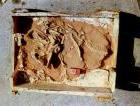 Poles caught a dinosaur in its own trail
Poles caught a dinosaur in its own trail
A dinosaur fossil with its foot imprint in the rock beside it was found in the Earth Museum in Warsaw. It is the world's first case where dinosaur trail can be directly linked to a particular dinosaur species.
Scientists reported the discovery in the prestigious magazine Cretaceous
Research. The authors of the publication are: Tomasz Singer from
Jurapark in Ostrowiec, Grzegorz Niedźwiedzki from the University of
Uppsala, Gerard Gierliński from Juraparku and Martin Lockley from the
University of Colorado in Denver. "This is the first such finding in the world" - co-discoverer, Gerard Gierliński described.
The specimen was for decades on display at the Earth Museum on Skarpa in
Warsaw. It was identified by a student, who worked on the skeleton
while preparing his MA thesis.
The remains are of Protoceratops,
ancestor of horned dinosaurs, with jaws ending with a strong beak. This
is one of the dinosaur species typically found in the Gobi Desert in
Mongolia. This particular specimen is 80 million years, and the Polish
and Mongolian explorers found it in 1965.
Gierliński added that
so far dinosaurs skeletons had been linked to footprints by
reconstructing the trail on the basis of the skeleton feet, if it had
been preserved. More often, however, the process was reversed. Based on
the trail, skeleton foot was reconstructed and then compared to the
found bones of a similar age as those footprints.
"In this case,
we can directly link the skeleton to the footprint of a particular
species and a particular individual. It is quite a unique situation when
it comes to dinosaurs" - said the palaeontologists.
Gierliński
explained that this discovery is very important for palaeontological
studies, because linking fossilized footprints to animals that lived in
prehistoric times on Earth is a huge problem. With this type of find, we
are one hundred percent certain that this type of trail had been made
by that particular animal.
"The only similar case concerned an
animal from before few thousand years, from the days when the old man
had already lived on earth. It was a North American jaguar, trapped in a
cave. Before it died from thirst and hunger, it walked nervously around
the cave, leaving footprints in the ground. But we otherwise know, what
kind of trail jaguar leaves, so it was not quite as revealing for
science, rather a curiosity" - reminded Gierliński.
He added that
Protoceratops skeleton was brought in the 1970s from a Polish-Mongolian
expedition to the Gobi. It was one of the famous expeditions of the
Polish Academy of Sciences headed by Prof. Zofia Kielan-Jaworowska.
"Some
of the specimens have not been fully processed and bones cleaned from
the rock and examined. Specimen in question, surprisingly, lay for
decades on display at the Earth Museum on Skarpa in Warsaw" - explained
Gierliński.
It was a block, a piece of rock containing a skeleton and secured with plaster.
"At
the beginning of the MA process of Tomasz Singer at the Institute of
Paleobiology PAS, the authorities decided that he should work on the
unprepared skeleton. During preparation, he found a suspicious structure
near the hind limb, which proved to be a footprint. He informed
Grzegorz Niedźwiedzki and me. We showed this finding to a renowned
dinosaur footprints specialist, Martin Lockley of the University of
Colorado in Denver. He expressed the desire to work on the find and
publish the result together, as a team. Detailed studies of specimen
took us three years" - the researcher concluded.
This really was
"a first", emphasised Martin Lockley in an interview with BBC Nature.
"We have a couple of examples in the literature where we say, +we're
almost certain that this footprint belongs to this species+, but this is
an animal actually dead in its tracks " - he added.
A single,
well-preserved trail is visible in the rock surrounding the fossil
bones. Prof. Lockley suggests that a fragment of rock, which splinted
during the preparation of the skeleton, may contain clues on the life of
the ancient inhabitant of the Earth. "Traditionally, palaeontologists
look for nice skeletons, and in order to get those out of the rock,
they're discarding the matrix. So lots of tracks have been overlooked" -
he explained.
Prof. Lockley noted that due to the new discovery,
fossil hunters will pay more attention to the footprints, which until
now they may have ignored. The study of footprints is important for a
better understanding of the life of dinosaurs.
"When
palaeontologists deal with skeletons, they're dealing with death and
decay - he said. - But with tracks you can tell how much it weighed, how
it moved, if it was running or walking. You can even tell if it was
limping. With tracks you're dealing with the living animals."
PAP - Science and Scholarship in Poland
last modification: 2011-10-14













































 Poles caught a dinosaur in its own trail
Poles caught a dinosaur in its own trail